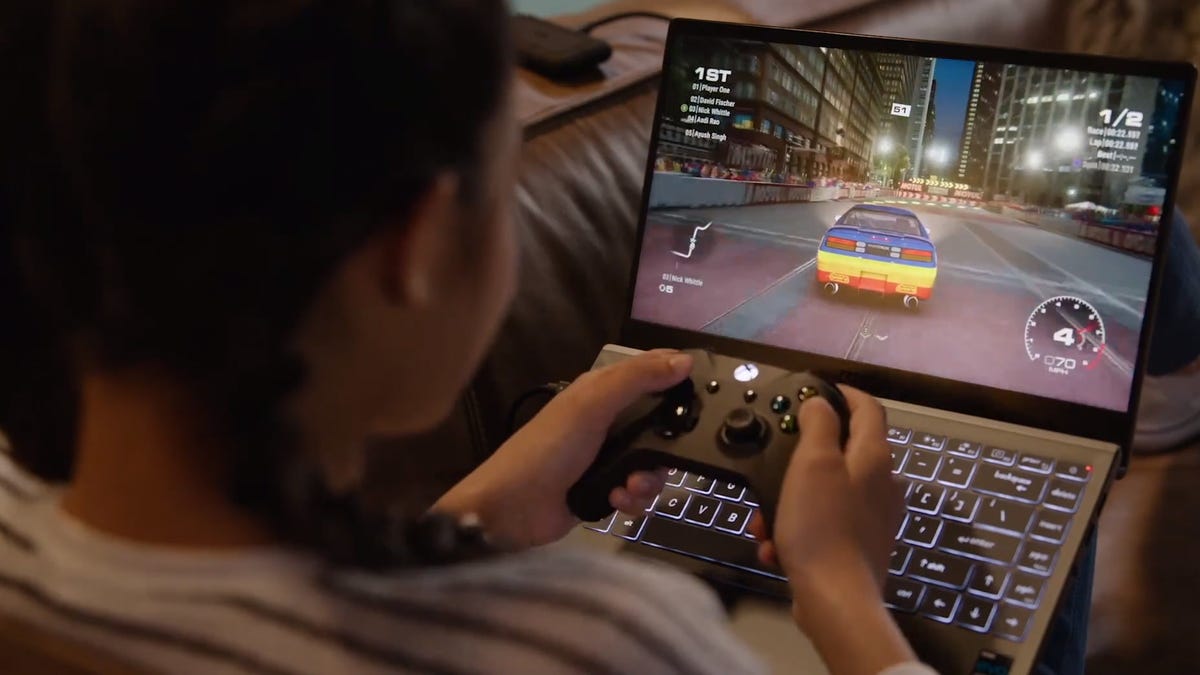Intel's 11th-Gen Laptop CPUs Will Make Laptops a Whole Lot Lighter, and Last a Whole Lot Longer - 5 minutes read
 Screenshot : Intel
Screenshot : IntelDuring a press event this morning, Intel officially announced the launch of its 11th-gen mobile processors, Tiger Lake, with Iris Xe Graphics that will be in “more than 150 designs” from several major manufacturers over the coming months. Intel says its new processors make it possible to have the thinnest and lightest laptops around, like the upcoming Asus ExpertBook that weighs only 1.9 lbs. These new processors also sip on power, so expect up to nine hours of battery life, as well as improved performance across all areas like work productivity, gaming, and image and video processing.
Advertisement
After five years, Intel is finally moving away from its 14nm transistors to 10nm with Tiger Lake bringing the architecture a little closer to competing with AMD. But instead of building hype around a smaller architecture, Intel focused on just how much of a performance boost these processors get compared to AMD’s current generation 4800U APUs—and even Nvidia’s MX350.
Last month, the company went into detail about its new architecture behind Xe graphics that will power its integrated and future discrete GPUs. At a glance, the integrated Xe Graphics looked powerful enough to run most games at 1080p and 60 frames per second. But today Intel showed off what that looks like next to AMD and Nvidia. On average, 11th-gen Intel with Iris Xe Graphics has nearly a 30 fps gain over AMD’s 4800U and a 10 fps gain over Nvidia’s MX350, depending on the game, putting it close to 60 fps.
Advertisement
Intel didn’t say what resolution it had the games set to across all three systems, nor if the graphics were cranked to the max, but I suspect all the systems were running at 1080p on at least medium graphics. The Intel system was probably running one of the higher-end, 11th-gen Core i7 mobile processors, as Intel did not specify the exact SKU. I’ll have to wait to get my hands on a laptop with Tiger Lake inside to see how it actually performs, but for the moment integrated Xe Graphics seem pretty impressive.
The company also showed a side-by-side photo colorization and upscaling comparison between its 11th-gen processor with Iris Xe Graphics and AMD’s 4800U APU. From what was shown, Intel’s processor was able to complete the task in under 40 seconds thanks to Intel DL Boost, which is designed to accelerate AI workloads, like colorizing and upscaling photos. AMD’s processor took over two minutes. When it came to video encoding, Intel was nearly 100% faster based on the footage that Intel showed.
Chris Walker, Intel Corporate Vice President and GM Mobile Client Platforms, shows off some of the laptops to include Intel’s 11th-gen processors with Iris Xe Graphics. Screenshot : Intel
Interestingly, Intel will roll out two versions of its 11th-gen processors: one with its new Iris Xe Graphics and one with its tried and true (and less powerful) UHD graphics. I’m guessing this is to create lower price points for users who are looking for a new laptop but don’t necessarily want or need the extra power that comes with the Xe graphics. But to help differentiate between the two, Intel is also launching Intel Evo—or a special label on 11th-gen Intel Core processors with Intel Iris Xe graphics that have been verified to Project Athena’s second edition specifications.
Intel says this means all laptops with the Intel Evo badge will be verified to wake up from sleep in less than one second, have nine or more hours of real-world battery life on systems with FHD displays, and get up to four hours worth of battery life in a single, 30-minute charge on systems with FHD displays. Laptops with the Intel Evo badge will also have Wi-Fi 6 and Thunderbolt 4 universal cable connectivity. Intel says more than 20 verified Evo designs are expected by the end of this year.
Advertisement
Here are the SKUs with Iris Xe Graphics:
Core i7-1185G7: 4-cores/8-threads, 96 Graphics (EUs), DDR4-3200 memory, 3.0 Ghz Base (4.3 Ghz all-core boost, 4.8 Ghz single-core boost), 1.35 Ghz max graphics frequency
4-cores/8-threads, 96 Graphics (EUs), DDR4-3200 memory, 3.0 Ghz Base (4.3 Ghz all-core boost, 4.8 Ghz single-core boost), 1.35 Ghz max graphics frequency Core i7-1165G7: 4-cores/8-threads, 96 Graphics (EUs), DDR4-3200 memory, 2.8 Ghz Base (4.1 Ghz all-core boost, 4.7 Ghz single-core boost), 1.30 Ghz max graphics frequency
4-cores/8-threads, 96 Graphics (EUs), DDR4-3200 memory, 2.8 Ghz Base (4.1 Ghz all-core boost, 4.7 Ghz single-core boost), 1.30 Ghz max graphics frequency Core i7-1160G7: 4-cores/8-threads, 96 Graphics (EUs), DDR4-3200 memory, 4.4 GHz base (3.6 Ghz all-core boost, 4.4 Ghz single-core boost), 1.10 Ghz max graphics frequency
4-cores/8-threads, 96 Graphics (EUs), DDR4-3200 memory, 4.4 GHz base (3.6 Ghz all-core boost, 4.4 Ghz single-core boost), 1.10 Ghz max graphics frequency Core i5-1135G7: 4-cores/8-threads, 80 Graphics (EUs), DDR4-3200 memory, 2.4 GHz base (3.8 Ghz all-core boost, 4.2 Ghz single-core boost), 1.30 Ghz max graphics frequency
4-cores/8-threads, 80 Graphics (EUs), DDR4-3200 memory, 2.4 GHz base (3.8 Ghz all-core boost, 4.2 Ghz single-core boost), 1.30 Ghz max graphics frequency Core i5-1130G7: 4-cores/8-threads, 80 Graphics (EUs), 1.1 GHz base (3.4 Ghz all-core boost, 4.0 Ghz single-core boost), 1.10 Ghz max graphics frequency
Advertisement
None of the new Core i3 variants will come with Iris Xe Graphics, but they’ll use the Intel UHD Graphics instead.
On paper, these new processors seem mighty impressive, and in a world where thinner, lighter laptops are all the rage, but could do better performance-wise, Intel just may have created a new design that lets consumers have their cake and eat it too. Hopefully, we’ll get our hands on a few laptop configurations soon to see just how powerful these processors are.
Source: Gizmodo.com
Powered by NewsAPI.org